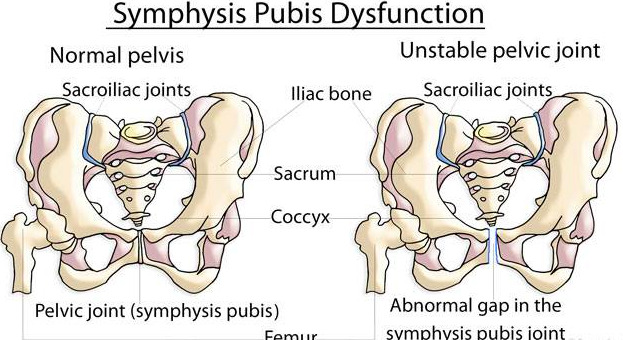
What to do About Pubic Pain


The pubis symphysis is a cartilage that functions as a joint to connect the ilium plates in the front of your pelvis. As it holds the pelvis together in the front, it plays an essential role in maintaining stability for weight transfer from one leg to the other.
What causes Symphysis Pubis Dysfunction (SPD)
- Hormone – relaxin, during pregnancy the ligaments become lax as the body prepares for childbirth. Resultantly, the space in the pubis symphysis widens, causing instability allowing for more movement than usual
- Prior pelvic trauma
- Hypermobility – Connective tissue disorders increase instability (Ehlers-Danlos Syndrome)
- Pelvic joints not moving properly (unequal muscle pull)
- Baby positioning – if the little one baby is posterior, asynclitic (head is tilted) or transverse, it may lead to increased pressure or pain on the pubic bone
- Repetitive motion- with occupations, hobbies, or fitness routines were/are one-sided, this can lead to muscular imbalances, leading to uneven force transfer and mobility/stability
Another reason for SPD is partial dislocation or subluxation of the pubis, which consequently weakens stability as well.
Symptoms of pubis symphysis pain:
- Sharp or shooting pain at front of pelvis, vagina, rectum, or pelvis
- Pelvic/pubic radiating to upper thigh/groin
- Throbbing or deep achy pain around hips, low back, lower abdomen, or perineum (between vagina and anus)
- Pain with transferring weight from one leg to another – pain with walking, standing on one leg, climbing stairs, getting in/ out of the car or bed, and rolling over in your sleep
- Clicking or popping sound of pelvis accompanied with pain or discomfort
- “Pregnancy waddle” to avoid pain
Do’s and Don’ts:
- Do go up the stairs one at a time or go up sideways
- When putting on and taking off pants, do it from a seated position
- Use shorter strides while walking
- When getting out of a car, swivel your hips and keep your knees together
- Sleep on your side with a pillow between your legs
- Sit with legs parallel, do your best to not cross your legs
- Avoid asymmetrical exercises (i.e lunges)
- Don’t stand on one leg and get dressed
- Don’t over stretch
Here are some ways to find relief:
- Good posture and pelvic alignment:
- As you stand and walk your diaphragm (muscle under rib cage) should be aligned with your pelvic floor — this is a neutral spine. If you drop you’re your hips too much forward or arch your back too much this can increase pain/pressure on the pubic region. So one easy exercise is to stand in front of a mirror and focus on finding that neutral spine.
- Diaphragmatic breathing:
- Get into a comfortable position. You may stand, sit or lay down on your back.
- Place one hand on your chest and one hand on your stomach. The hand on your chest should stay still. The hand on your stomach will allow you to feel your stomach rise and fall as you breathe
- Breathe in through your nose if you can for 3-5 seconds, or as long as you are comfortable. Allow your stomach to rise and fill your lungs, making your belly big.
- Breathe out through your mouth if you can for 3-5 seconds, or as long as you are comfortable. Allow your stomach to fall as the air leaves your lungs.
- Strengthen Pelvic floor aka KEGEL:
- Lift, squeeze, tighten, draw in all mean kegel.
- Pull the anus as if stopping gas from passing. Your buttocks should stay relaxed as this happens. Tighten your anus and lift inwards to feel an inward squeezing sensation inside and around your anus.
- Tighten and squeeze the entrance to the vagina as if you’re closing it shut and lifting it. Imagine a string drawing your vagina up inside your body as if to resist withdrawing a tampon. Or you are picking up a marble into the vaginal canal
- Tighten the opening where the urine comes out (urethra). If you feel your anus and vagina tightening too, that is good!
- With practice, combine them all!
- Quick Kegels: Hold kegel for 2 seconds on and 2 seconds off.
- Hold Kegels: Hold kegel for 5 seconds, count aloud as you hold.
- Deep Core Muscle Engagement (Transverse Abdominus):
- Take an in inhale. And on the exhale, GENTLY draw your belly button back. The abdominals are drawing gently inwards, but not pulling in hard. Making an ‘Ssssss’ sound as you exhale may help you find the right deep abdominal muscles.
- Imagine there is a string around your hip bones. Draw the string inwards towards your belly button.
- When you are contracting this muscle, you shouldn’t feel any movement of your hips, pelvis, or spine.
- Connect Deep Core and Pelvic for:
- From above: first, engage deep core muscles and then add a hold kegel.
- You should be able to continue to breathe throughout this.
Exercises: If any of these are painful discontinue or ask for a modification
- Glut squeezes
- Begin by lying on your back. Slowly squeeze your buttock muscles together.
- Hold for 5 seconds x 20 reps.
- Bridges
- Begin by lying with knees bent and both feet placed on the floor with arms at your sides. Raise your hips off the surface by squeezing your buttock muscles. Attempt to bring the hips up to where they are in line between the knees and shoulders. Slowly lower back to starting position.
- 2 sets of 10 reps.
- Kneeling squats
- Kneel down on top of a cushion or rolled-up yoga mat with your knees separated slightly.
- Next, sit back and down until your buttocks are in contact with your heels.
- From here, engage deep core and then squeeze your buttock muscles to extend your hips.
- Hold the top position for 2 seconds, and then slowly come back down to the starting position.
- 2 sets of 10 reps
- Pelvic tilt in sitting or standing
- Begin standing with your hands on your hips. Slowly perform an anterior pelvic tilt by gently rolling your hips forward, arching your lower back.
- Return to starting position, and then perform a posterior pelvic tilt by using your abdominals, gently rolling your hips backwards, feeling your low back flatten out.
- Be sure to keep your upper trunk and legs relaxed throughout.
- 2 sets of 10 reps
- Ball squeeze:
- Begin lying on your back with your knees and a pillow or ball between your knees.
- Gently squeeze the pillow or ball with your legs, hold briefly, then relax and repeat. There should be little to no movement during the exercise.
- 2 sets of 10 reps, 5-second holds.






